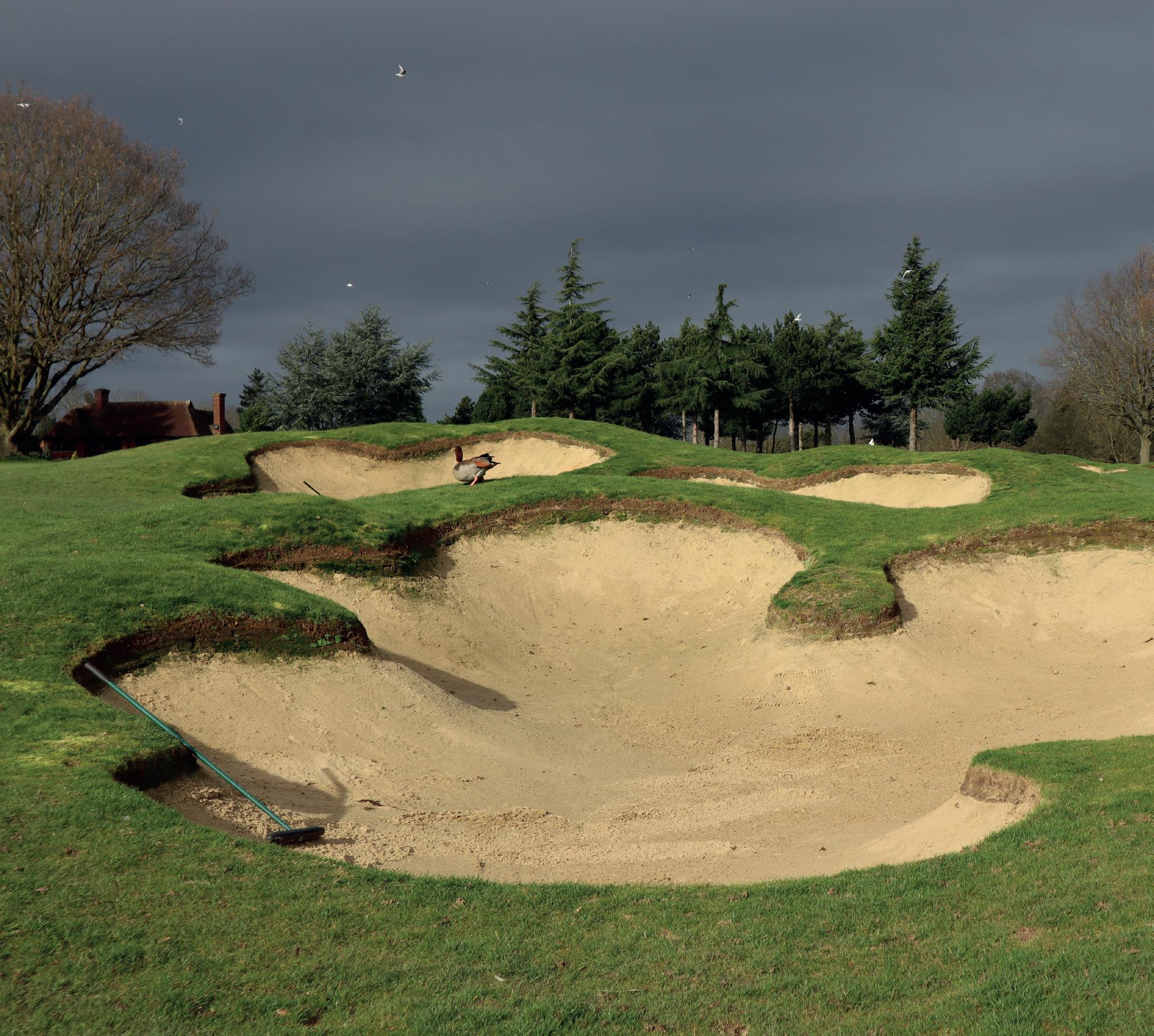
9 minute read
How Stoke Park changed their sand traps
How Stoke Park found their place among GOLF’S A-LISTERS
Three years, and more than 100 bunkers, the project to renovate every trap at Stoke Park was a huge one. So how did they do it and what can we learn?
Advertisement
You’ve got one of golf’s iconic clubhouses, food and beverage options to die for and a hotel ranked with the world’s best.
But while everything else was worthy of an Oscar at Stoke Park, the 300-acre country estate that’s played host to so many of Hollywood’s movie A-listers, something wasn’t quite living up to the same billing.

It was the golf course or, more specifically, the bunkers.
Harry Colt first realised Nick ‘Pa’ Lane Jackson’s dreams of a Buckinghamshire retreat in the first decade of the 20th century.
Over the last 100 years, one thing has remained constant about the golf course, which currently stands at 27 holes in three loops of nine – plentiful sand.
But as many clubs know, bunkers can change dramatically over the years as greenkeepers and committees move, alter or install new ones.
It was no exception at Stoke Park. But when the principle of design relied so much upon them, a century of tinkering had taken its toll.
“The inconsistency of shapes was the problem,” explained director of golf Stuart Collier. “Once you really started to delve into the project and focus on it, there must have been about six different styles and shapes. “There was legacy work from different greenkeepers, or
committees in the past dating back to when it was a private members’ club.
“There were so many different looks on the course that there was no flow or consistency to it at all.” It wasn’t just an aesthetic issue. When the weather turned, the deteriorating bunkers gave Collier and the greenkeeping team major headaches.
He added: “On a number of holes water would come running off the green and just dump straight into the greenside bunker.
“The 4th was a classic example. The left hand corner of the greenside bunker would just wash out permanently.
“If there was a weekend medal, and we’d had rain on Friday night, when we came in on Saturday morning before the members’ competition we knew which traps we would immediately need to get to.
“Some days the decision would be to take these out of play if we couldn’t find a suitable area to take relief. That simply hasn’t happened once since we’ve carried out the project.”
Just as pertinently, the bunkers kept coming up as a red flag when the club talked to customers. Whether it was member surveys, or visitor feedback from casual golf or corporate days, a consistent message emerged.
For Collier, that was important. It provided impetus and direction when it came to setting future strategy.
“It gave us the justification to sit down with the owners and say ‘when we are in the position to invest in the golf course, that’s going to be the primary area for us to tackle’.”
They brought in John Greasley Limited to do the work over three winters, with nine holes closed and completed each year on a sixmonth turnaround.
That began with the Colt 9 in the winter of 2015/16, moved on to the Alison layout and finished with the Lane Jackson complex in the spring of 2018.
“We had a blueprint in our head of how we wanted the bunkers to look,” described Collier of the project.
“They’re a big feature of the golf course now and a statement of what’s out there. They were just so uninspiring before. Location wise, they were great.
“We’ve simplified areas and we’ve made bunkers smaller. There were collections, like the left hand side of the 3rd green, where there were four small saucer shaped bunkers and a lot of maintenance required. “Quite often, they were so small you had one foot in and one foot out. It just made perfect sense to clean that area up – one trap only. “There were a lot of things that were very straightforward. We didn’t need to tinker with the positioning too much. It also gave us an opportunity to review some of the locations for driving distances and modernise that as carry distances are quite different now. For us, though, it was much more about the look and the shapes than altering the actual layout too much.”
With a seven-figure budget to play with, you might be wondering what your club could learn from Stoke Park’s example as you consider your own bunker renovations on tighter finances. But their challenges arose from issues that are universal to us all. How they dealt with them is instructive.
“The first year was the wettest and key was managing the movement of their (Greasley’s) vehicles,” Collier said.
“Which hole would we start on? How were they going to work their way back out? At the 6th, for example, which is a long par 4 up the hill, the whole of the right hand side was pretty much mud with all the tracks going through there. “We were very quickly onto managing what route they’ve got and how not to affect golfers going forward. That was a big part of the plan for which order we were doing holes on the other 9s so as to get the course reinstated as quickly as possible.
“One element we are learning a lot more about post work, that we
never considered at all, is how to manage moisture levels in a bunker. “Everything we’ve built is designed to help move the water off the greens and away from the bunkers. With the liner product, and fresh drainage, any water coming into the bunkers passes straight through. We’ve had no washout whatsoever. The problem then is that you start to get a product that is maybe more powdery than you’d wish.
“We’ve now had to start looking at how we manage irrigation around and into the bunkers. So considering moisture levels, and thinking about irrigation as part of that project, was certainly something we hadn’t anticipated.” Managing customer expectation, both positive and negative, also proved important once the diggers had left, as Collier also explained.

“It’s not something everyone loves because everyone is looking for something different from the golf course. The golf course is certainly tougher for the higher handicapper and older golfer, the player who hasn’t got as much speed, can’t control, or isn’t as aware of where their club is impacting the sand.
“In the older bunkers, because they were very stony, compacted and flat, you could pretty much hit any club out of any trap.
“Now you’ve got to strike it properly and to get the correct elevation you’ve got to make sure you’ve chosen the right club.
“Some golfers have found that harder and a bit more challenging but, around the green, you certainly know how it is going to react all the time now. You’ve got a consistent amount of sand. There’s never any challenge of having enough loft to get it up and out. “Previously, you’d settle your feet in and say ‘okay, a bit of sand underneath the ball’ and then the club would get to impact and there’s nothing there.”
The effect of the work has been remarkable. Stand on the tee of the 8th, for example, and while the shot looks formidable as your eye tries to thread a way through what seems like a sea of sand, the consistent and attractive shaping lifts the experience.
It’s the same hole, only better. “Visually now you stand on any hole and you understand how you need to play it and what the choices are,” concluded Collier. “What has been achieved is to bring the course up to date while retaining all the qualities in the original course.”
HEART TO HEART

Steve Robinson visits Mid Herts Golf Club and speaks with General Manager Joy Pickard

Joy, you have been using rijo42 for a number of years now, from your experience what is it that sets us apart from other coffee providers?
Having been a customer of rijo42 at my previous golf club, on joining Mid Herts as the new General Manager I was able to convince the Board of Management to dispense with the basic coffee machine from behind the bar. The selling points that sets rijo42 apart from other coffee providers that won over not just the board, but also the members, is the consistent quality of the coffee and the ease of use with the machine. Members and visitors alike enjoy the opportunity of selecting their coffee option and being in control. The 10oz serving combined with the attractive crockery was also a winner and from a customer point of view, the prompt delivery service and efficiency of the technical team plays an important part in being able to provide the level of service the members expect.
I’m sure over the past few years you have witnessed a significant increase in sales of coffee, what’s your advice to anyone when it comes to maximising the potential in this area and how significant is it in maintaining a busy clubhouse?
To encourage people into the clubhouse they need a reason and the idea of meeting up with friends for a ‘coffee morning’ is something that rijo42 allows us to offer. By situating our coffee machine in a prominent position within the club, with easy access at all times, people are encouraged to make use of it. The pavement sign has proven a useful tool in attracting the local rambling groups to stop by the clubhouse for a coffee along the way and we are now offering a ‘cake of the day’ to accompany their coffee, giving our franchise caterer a small revenue stream. The Pilates and Yoga groups who attend daily/weekly sessions at our purpose-built studio on the upper floor often finish their morning with a coffee knowing that it is only 55 calories a cup, meaning they don’t feel guilty after a hard workout! The ‘take out’ cups are very popular with the early morning golfers who will purchase a few tokens in advance and can pop in and pick up a coffee – some even forgo the take out cup and fill up their own Thermos! You have recently taken delivery of the new RSD Touch Brasil and cup warmer. Having used our equipment for many years, what’s the stand out features that impress you about the new model and how has it gone down with your members?
The new RSD Touch has given the option to offer decaffeinated coffee, which is proving popular and the touch screen operation has been a real winner. With the addition of the Cup Warmer, members are finding their coffee stays hot for longer, especially in the winter months. The RSD screen has given us another opportunity for advertising and as we become more familiar with the functionality, we look to maximise the use of the display. There is no better way to capture the attention of someone than when they are standing facing the coffee machine waiting for their coffee to be dispensed!











